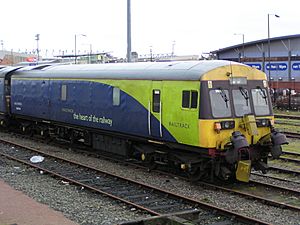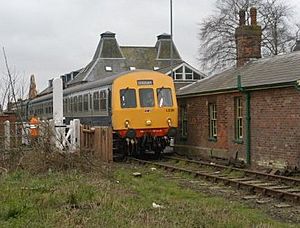British Rail Class 101 facts for kids
Quick facts for kids British Rail Class 101 |
|
|---|---|

Class 101, no. 101692 (formed of vehicles 53170 + 53253) at Arley on the Severn Valley Railway on 15 October 2004. This train was part of the Railcar 50 event. It was painted in Caledonian Blue in 1996 for a new train line. Later, it moved to Manchester and was one of the last six trains of its kind. It stopped running in October 2003 and is now kept at the Midland Railway Butterley.
|
|
| In service | 1956–2003 |
| Manufacturer | BREL |
| Number built | 1956–1959 |
| Formation | 2 cars per trainset |
| Operator(s) | British Rail |
| Specifications | |
| Car length | 17.37 m |
| Width | 2.81 m |
| Height | 3.77 m |
| Maximum speed | 75 mph (121 km/h) |
| Weight | 32.5 tonnes |


The Class 101 trains were a type of diesel multiple unit (DMU) used by British Rail. A DMU is a train that has its own engine and can run by itself. These trains were built by Metro-Cammell in Birmingham between 1956 and 1959. Before these, some test trains were made.
The Class 101 became the most successful and longest-lasting of all the "First Generation" DMUs in Britain. The very last five trains of this type stopped running on 24 December 2003. By then, the oldest train was more than 47 years old!
Contents
What Made the Class 101 Special?
The Class 101 trains were very popular. They were known for being reliable and strong. They could carry many passengers across different parts of the country.
Design and Features
These trains usually had two cars linked together. Each car was about 17 meters long. They could reach a top speed of 75 miles per hour (121 km/h). This made them good for both local and longer journeys.
Where Did They Run?
Class 101 trains served many routes across the United Kingdom. They were a common sight on British railways for nearly 50 years. They helped millions of people travel every day.
End of an Era
By the early 2000s, newer trains were being built. The Class 101s were slowly taken out of service. The very last ones stopped running in 2003. This marked the end of a long and important chapter in British railway history.
Preserved Trains
Even though they are no longer used for regular travel, some Class 101 trains have been saved. They are now kept at railway museums and heritage lines. People can visit these places to see and sometimes even ride on these historic trains. This helps keep their story alive for future generations.
Images for kids
-
101680 in old Regional Railways colors at Sheffield in 1998.
-
A Class 101 train at Bradford Interchange next to a Class 150 train.
-
NSE 101 L832 Sarah at Reading station.
-
First North Western train 101685 at Manchester Piccadilly on December 24, 2003. This was its last day of service.







